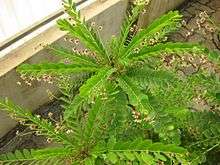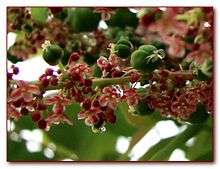Phyllanthus
| Phyllanthus | |
|---|---|
 | |
| Phyllanthus mirabilis | |
| Scientific classification | |
| Kingdom: | Plantae |
| (unranked): | Angiosperms |
| (unranked): | Eudicots |
| (unranked): | Rosids |
| Order: | Malpighiales |
| Family: | Phyllanthaceae |
| Tribe: | Phyllantheae |
| Genus: | Phyllanthus L. |
| Diversity | |
| About 800 species | |
| Synonyms[1] | |
|
List
| |



Phyllanthus is the largest genus in the flowering plant family Phyllanthaceae. Estimates of the number species in this genus vary widely, from 750[2] to 1200.[3] Phyllanthus has a remarkable diversity of growth forms including annual and perennial herbs, shrubs, climbers, floating aquatics, and pachycaulous succulents. Some have flattened leaflike stems called cladodes. It has a wide variety of floral morphologies and chromosome numbers and has one of the widest range of pollen types of any seed plant genus.
Despite their variety, almost all Phyllanthus species express a specific type of growth called "phyllanthoid branching" in which the vertical stems bear deciduous, floriferous (flower-bearing), plagiotropic (horizontal or oblique) stems. The leaves on the main (vertical) axes are reduced to scales called "cataphylls", while leaves on the other axes develop normally.[4] Phyllanthus is distributed in all tropical and subtropical regions on Earth.
Species
The circumscription of this genus has been a cause of much confusion and disagreement. Molecular phylogenetic studies have shown that Phyllanthus is paraphyletic over Reverchonia, Glochidion, Sauropus, and Breynia. A recent revision of the family Phyllanthaceae has subsumed all four of these genera into Phyllanthus.[5] This enlarged version of Phyllanthus might eventually be divided into smaller genera,[6][7] including 32 Chinese (and northern Indochinese) species.[8]
- Phyllanthus abnormis Baill. - Drummond's leafflower
- Phyllanthus acidus (L.) Skeels - Otaheite gooseberry
- Phyllanthus acuminatus Vahl - Jamaican gooseberry tree
- Phyllanthus amarus Schumacher
- Phyllanthus angustifolius (Sw.) Sw.
- Phyllanthus arbuscula (Sw.) J.F.Gmel.
- Phyllanthus atropurpureus Bojer
- Phyllanthus brasiliensis (Aubl.) Poir.
- Phyllanthus caesiifolius Petra Hoffm. & Cheek
- Phyllanthus caroliniensis Walt. - native to the Americas
- Phyllanthus cochinchinensis (Lour.) Spreng.
- Phyllanthus cuneifolius (Britt.) Croizat
- Phyllanthus debilis Klein ex Willd.
- Phyllanthus emblica L. - Indian gooseberry, also known as amla or amalaki.
- Phyllanthus engleri Pax
- Phyllanthus epiphyllanthus L.
- Phyllanthus ericoides Torr.
- Phyllanthus fluitans - red root floater, sometimes sold in aquarium shops
- Phyllanthus fraternus G.L.Webster
- Phyllanthus gentryi Webster
- Phyllanthus grandifolius L.
- Phyllanthus haughtii Croizat
- Phyllanthus hakgalensis
- Phyllanthus juglandifolius Willd.
- Phyllanthus lacunarius F.Muell.
- Phyllanthus liebmannianus Muell.-Arg.
- Phyllanthus maderaspatensis L.
- Phyllanthus microcladus Muell.-Arg.
- Phyllanthus mirabilis Müll.Arg. - the only succulent species of this genus
- Phyllanthus myrtifolius - Wight. Muell. Arg.
- Phyllanthus muellerianus (Kuntze) Exell
- Phyllanthus niruri L. - Chanca piedra (Also includes P. amarus and P. debilis)
- Phyllanthus parvifolius Buch.-Ham. ex D.Don
- Phyllanthus piscatorum Kunth
- Phyllanthus pentaphyllus C. Wright ex Griseb.
- Phyllanthus polygonoides Nutt. ex Spreng. - Smartweed leafflower
- Phyllanthus polyspermus Shumach. & Thonn. - often misidentified as P. reticulatus[9]
- Phyllanthus profusus N.E.Br.
- Phyllanthus pseudocanami Müll.Arg.
- Phyllanthus pudens L.C. Wheeler
- Phyllanthus pulcher Wallich ex Muell.-Arg.
- Phyllanthus reticulatus Poir. - Asian sp. similar in appearance to P. polyspermus[9]
- Phyllanthus saffordii Merr.
- Phyllanthus salviifolius Kunth
- Phyllanthus sepialis Müll.Arg.[10]
- Phyllanthus stipulatus (Raf.) G.L. Webster
- Phyllanthus taxodiifolius Beille
- Phyllanthus tenellus Roxb.
- Phyllanthus urinaria L. - chamberbitter
- Phyllanthus virgatus G.Forst.
- Phyllanthus watsonii A. Shaw
- Phyllanthus welwitschianus Müll.Arg.
For full list, see List of Phyllanthus species.
Pollination biology
Phyllanthus are of note in the fields of pollination biology and coevolution because some but not all species in the genus have a specialized mutualism with moths in the genus Epicephala (leafflower moths), in which the moths actively pollinate the flowers. While ensuring that the tree may produce viable seeds, the moths also lay eggs in the flowers' ovaries where their larvae consume a subset of the developing seeds as nourishment.[11][12] Other species of Epicephala are pollinators of certain species of plants in the genera Glochidion[13][14] and Breynia,[15][16] both of which are phylogenetically nested within Phyllanthus.[17]
Research and traditional medicine
Particularly for its content of tannins, P. emblica fruit has a history of use in traditional medicine and is under study for its potential biological properties.[18] Leaves, roots, stem, bark and berries of this genus contain lignans and other phytochemicals.[19][20][21]
Phyllanthus species have been assessed for use in people with chronic hepatitis B virus infection, but the low quality of clinical trials has prevented any conclusion about efficacy as of 2013.[22][23]
References
- ↑ "World Checklist of Selected Plant Families".
- ↑ David J. Mabberley. 2008. Mabberley's Plant-Book. third edition (2008). Cambridge University Press.
- ↑ Kathriarachchi H, Hoffmann P, Samuel R, Wurdack KJ, Chase MW (July 2005). "Molecular phylogenetics of Phyllanthaceae inferred from five genes (plastid atpB, matK, 3'ndhF, rbcL, and nuclear PHYC)". Molecular Phylogenetics and Evolution. 36 (1): 112–34. PMID 15904861. doi:10.1016/j.ympev.2004.12.002.
- ↑ Webster, Grady L. (1994). "Classification of the Euphorbiaceae". Annals of the Missouri Botanical Garden. 81 (1): 3–32. JSTOR 2399908. doi:10.2307/2399908.
- ↑ Hoffmann, Petra; Kathriarachchi, Hashendra S.; Wurdack, Kenneth J. (2006). "A Phylogenetic Classification of Phyllanthaceae". Kew Bulletin. 61 (1): 37–53.
- ↑ Kathriarachchi, Hashendra S.; Samuel, Rosabelle; Hoffmann, Petra; Mlinarec, Jelena; Wurdack, Kenneth J.; Ralimanana, Hélène; Stuessy, Tod F.; Chase, Mark W. (2006). "Phylogenetics of tribe Phyllantheae (Phyllanthaceae) based on nrITS and plastid matK DNA sequence data". American Journal of Botany. 93 (4): 637–655. PMID 21646224. doi:10.3732/ajb.93.4.637.
- ↑ Kanchana Pruesapan, Ian R.H. Telford, Jeremy J. Bruhl, Stefano G.A. Draisma, and Peter C. Van Welzen. 2008. "Delimitation of Sauropus (Phyllanthaceae) Based on Plastid matK and Nuclear Ribosomal ITS DNA Sequence Data." Annals of Botany 102(6):1007-1018
- ↑ "Flora of China". eFlora. Retrieved 18 April 2017.
- 1 2 Luo, S.X., H.-J. Esser, D. Zhang, and S. S. Renner. 2011. Nuclear ITS sequences help disentangle Phyllanthus reticulatus (Phyllanthaceae), an Asian species not occurring in Africa, but introduced to Jamaica. Systematic Botany 36(1): 99-104.
- ↑ Bussmann, R. W.; Gilbreath, GG; Solio, J; Lutura, M; Lutuluo, R; Kunguru, K; Wood, N; Mathenge, SG (2006). "Plant use of the Maasai of Sekenani Valley, Maasai Mara, Kenya". J Ethnobiol Ethnomed. 2: 22. PMC 1475560
 . PMID 16674830. doi:10.1186/1746-4269-2-22.
. PMID 16674830. doi:10.1186/1746-4269-2-22. - ↑ Kawakita, A.; Kato, M. 2004. "Evolution of obligate pollination mutualism in New Caledonian Phyllanthus (Euphorbiaceae)." American Journal of Botany 91: 410–415.
- ↑ Kawakita, A.; Kato, M. 2009. "Repeated independent evolution of obligate pollination mutualism in the Phyllantheae-Epicephala association." Proceedings of the Royal Society B. 276: 417–426.
- ↑ Hembry, D. H.; Okamoto, T.; Gillespie, R. G. (2012) Repeated colonization of remote islands by specialized mutualists. Biology Letters. 8: 258–261.
- ↑ Luo, S.-X.; Yao, G.; Wang, Z.; Zhang, D.; Hembry, D. H. (2017) "A novel, enigmatic basal leafflower moth lineage pollinating a derived leafflower host illustrates the dynamics of host shifts, partner replacement, and apparent co-adaptation in intimate mutualisms." The American Naturalist. 189: 422–435
- ↑ Kawakita, A.; Kato, M. 2004. Obligate pollination mutualism in Breynia (Phyllanthaceae): further documentation of pollination mutualism involving Epicephala moths (Gracillariidae). American Journal of Botany. 91: 1319–1325.
- ↑ Zhang, J.; Wang, S.; Li, H.; Hu, B.; Yang, X.; Wang, Z. 2012. "Diffuse coevolution between two Epicephala species (Gracillariidae) and two Breynia species (Phyllanthaceae). PLOS ONE. 7: e41657.
- ↑ Kathriarachchi, H.; Samuel, R.; Hoffmann, P.; Mlinarec, J.; Wurdack, K. J.; Ralimanana, H.; Stuessy, T. F.; Chase, M. W. 2006. "Phylogenetics of tribe Phyllantheae (Phyllanthaceae: Euphorbiaceae sensu lato) based on nrITS and plastid matK DNA sequence data." American Journal of Botany. 93: 637–655.
- ↑ Yang, B; Liu, P (2014). "Composition and biological activities of hydrolyzable tannins of fruits of Phyllanthus emblica". Journal of Agricultural and Food Chemistry. 62 (3): 529–41. PMID 24369850. doi:10.1021/jf404703k.
- ↑ Murugaiyah V, Chan KL (June 2007). "Determination of four lignans in Phyllanthus niruri L. by a simple high-performance liquid chromatography method with fluorescence detection". Journal of Chromatography A. 1154 (1–2): 198–204. PMID 17418855. doi:10.1016/j.chroma.2007.03.079.
- ↑ Srivastava V, Singh M, Malasoni R, et al. (January 2008). "Separation and quantification of lignans in Phyllanthus species by a simple chiral densitometric method". Journal of Separation Science. 31 (1): 47–55. PMID 18064620. doi:10.1002/jssc.200700282.
- ↑ Bagalkotkar G, Sagineedu SR, Saad MS, Stanslas J (December 2006). "Phytochemicals from Phyllanthus niruri Linn. and their pharmacological properties: a review". The Journal of Pharmacy and Pharmacology. 58 (12): 1559–70. PMID 17331318. doi:10.1211/jpp.58.12.0001.
- ↑ Liu, J; Lin, H; McIntosh, H (2001). "Genus Phyllanthus for chronic hepatitis B virus infection: A systematic review". Journal of Viral Hepatitis. 8 (5): 358–66. PMID 11555193.
- ↑ Xia, Y; Luo, H; Liu, J. P.; Gluud, C (2013). "Phyllanthus species versus antiviral drugs for chronic hepatitis B virus infection". The Cochrane Database of Systematic Reviews (4): CD009004. PMID 23633363. doi:10.1002/14651858.CD009004.pub2.
| Wikimedia Commons has media related to Phyllanthus. |
External links
- Kathriarachchi, Hashendra; Hoffmann, Petra; Samuel, Rosabelle; Wurdack, Kenneth J.; Chase, Mark W. (2005). "Molecular phylogenetics of Phyllanthaceae inferred from five genes (plastid atpB, matK, 3′ndhF, rbcL, and nuclear PHYC)". Molecular Phylogenetics and Evolution. 36 (1): 112–34. PMID 15904861. doi:10.1016/j.ympev.2004.12.002.
- Pruesapan, K.; Telford, I. R. H.; Bruhl, J. J.; Draisma, S. G. A.; Van Welzen, P. C. (2008). "Delimitation of Sauropus (Phyllanthaceae) Based on Plastid matK and Nuclear Ribosomal ITS DNA Sequence Data". Annals of Botany. 102 (6): 1007–18. PMC 2712409
 . PMID 18854375. doi:10.1093/aob/mcn193.
. PMID 18854375. doi:10.1093/aob/mcn193.